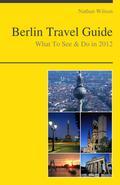Our illustrated travel guide will take you to Berlin, Germany. Berlin is best known for its historical associations as the German capital, internationalism and tolerance, lively nightlife, its many cafes, clubs, and bars, street art, and numerous museums, palaces, and other sites of historic interest. Berlin's architecture is quite varied. Although badly damaged in the final years of World War II and broken apart during the Cold War, Berlin has reconstructed itself greatly, especially with the reunification push after the fall of the Berlin Wall in 1989. It is now possible to see representatives of many different historic periods in a short time within the city center, from a few surviving medieval buildings near Alexanderplatz, to the ultramodern glass and steel structures in Potsdamer Platz. Because of its tumultuous history, Berlin remains a city with many distinctive neighborhoods. Finding Internet access when out and about can be problematic so carry your mobile guidebook in the palm of your hand. We include a fully linked Table of Contents and internally to access context-specific information quickly and easily when offline. Many web links are included as well for additional information. Contents: Welcome To Berlin Districts Overview History People Talk Economy Orientation Arrivals By plane By bus By train By car Local Transportation Public transport ticketing By train By underground By tram By bus By bicycle By scooter Sightseeing Highlights Museums Private art galleries Churches Landmarks with observation decks History Zoo Fun Activities Explore Recreation Festivals Parades Theatre, Opera, Concerts, Cinema Theater Opera Cinema Concert Houses Sport Spa Studying Working Shopping Highlights Flea markets Credit Cards Dining Guide Waiters and tipping Restaurants Breakfast Bars, Clubs & Drinking Bars Clubs Accommodation Guide Popular hotel districts include: Communications Safety & Security Prostitution Local Help Embassies Local & Day Trips


